Chronology of Queen Victoria's life and rule
Travel The World
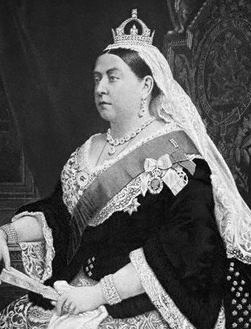
24 May 1819, Alexandrina Victoria was born. Victoria of Saxe-Coburg-Saalfeld (1786-1861), was the mother of Queen Victoria
of the United Kingdom. Her father was Prince Edward, Duke of Kent and Strathearn, the fourth son of King George III.
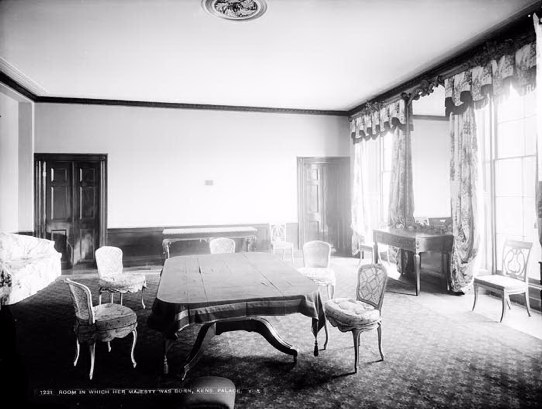
Kensington Palace, London - Birth room of Queen Victoria
1837, accession to the throne.
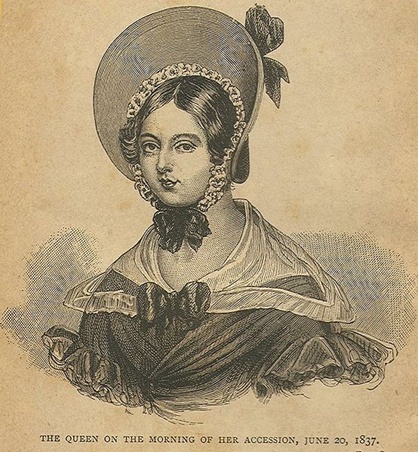
Victoria of the United Kingdom on the morning of her Accession to the Throne, June 20, 1837
June 20, 1838, coronation in Westminster Abbey.
June 28, Trans-Atlantic steam navigation inaugurated.
1839—Madman arrested for trying to enter Buckingham palace. Anti-corn law league found. British forces occupy Kabul. British took possession of Aden.
1840—Queen and Prince Albert married on 10 February 1840, in the Chapel Royal of St. James's Palace, London. Insane boy,
Edward Oxford, tries to shoot prince, consort and queen, June 1. Cheap postage introduced In England. Princess royal born,
Victoria Adelaide Mary Louise, oldest child of Queen Victoria and Prince Albert, later Empress Frederick, November 21. British
and Austrian expedition to Syria. Mohamet Ali sued for peace.
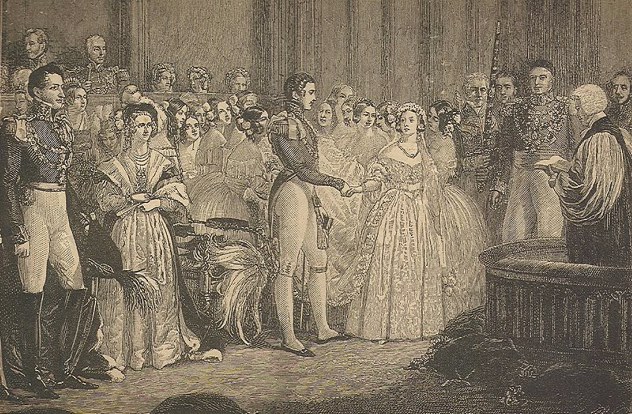
Marriage of Queen Victoria and Prince Albert, 10 February, 1840.
Prince Albert of Saxe-Coburg and Gotha was Prince Consort to Queen Victoria of the United Kingdom.
1841—Sir Robert Peel succeeds Lord Melbourne as premier. Prince of Wales born, November 9. Successful insurrection in
Kabul. British take Canton at Amoy, 26 August.
1842—John Francis, a cabinetmaker tried to shoot queen, May 30. John William Bean pointed pistol at queen, July 3. British withdraw
from Afghanstan. Hong Kong ceded to England. Chinese ports opened. British took Boer republic in Natal, South Africa.
1843—Princess Alice Maud Mary born, April 25. She was the third child and second daughter of Queen Victoria and Prince
Albert of Saxe-Coburg and Gotha. Suide annexed to British India. Queen and Prince Albert visit king and queen of France.
Prince Alfred born, August 8. Louis Philippe visits queen.
1845 —Seals of colonial office given to Mr. Gladstone. England and France made war on Juan Manuel de Rosas, dictator of Argentine republic.
Outbreak of first Sikh war. The First Anglo-Sikh War was fought between the Sikh Empire (Sikh kingdom
of Punjab) and the East India Company between 1845 and 1846.
1846—Princess Helena born May 25. Princess Helena (Helena Augusta Victoria; 25 May 1846 – 9 June 1923) was the third daughter and fifth
child of Queen Victoria and Prince Albert. Anglo- American treaty settling northwest boundary of the United States. Great famine in Ireland.
Corn laws repealed. Sikho defeated, ceded territory to East Indian company.
1847 —Queen Victoria "The Famine Queen" headed cash famine subscription to Ireland.
1848 —Princess Louise born, March 10. Princess Louise, (born Louise Caroline Alberta), was the sixth child and fourth daughter of Queen
Victoria and her husband, Albert.Queen and Prince Albert visit fugitive French royal family at Claremont. Great Chartist demonstration in London.
Insurrection in Ireland, attempted outbreak second Sikh war. Orange River sovereignty occu-pied. The Battle of Boomplaats took place on 29 August 1848. Gen.
Sir Harry G.W. Smith defeated the Boers.
1849—William Hamilton fired at queen, 19 May. Queen first visit to Ireland (Cork, Dublin and Belfast), 2 -12 August. Sikhs'
defeated. Panjab annexed to British India. The Second Anglo-Sikh War took place in 1848 and 1849.
1850—Prince Arthur born May 1. He was the seventh child and third son of Queen Victoria and Prince Albert of Saxe-Coburg
and Gotha. Robert Pate, a former British Army officer, attacked queen with a stick, 27 June. Clayton-Bulwer treaty concluded.
Taiping rebellion - The Taiping Rebellion was a civil war in southern China from 1850 to 1864, against the ruling Manchuled Qing Dynasty.
1851—Queen opens the Great Exhibition in The Crystal Palace in Hyde Park, 1st May. Prince Albert was heavily involved with
the organisation of the Great Exhibition of 1851. Burmah provoked British hostilities. Gold found in Australia.
1852—First Derby ministry succeeded Russell administration. Aberdeen succeeded Derby. London, protocol on succession in Denmark and Schleswig-Holstein.
British victors In Burmah, Peru acquired.
1853—Prince Leopold born April 7. He was the eighth child and fourth son of Queen Victoria and Prince Albert of Saxe-Coburg
and Gotha. Royal family visited Ireland.
1854 —Crimean war formally begun by the declaration of England and France against Russia. British-Japanese treaty. British permitted Orange Elver republic.
Commander MoClure accomplished northwest, passage.
1855—French emperor and empress visit the queen at Windsor, and the visit is returned in Paris. Henry John Temple, 3rd Viscount
Palmerston (Lord Palmerston) succeeded George Hamilton-Gordon, 4th Earl of Aberdeen (Lord Aberdeen) as Prime minister. Livingstone discovered Victoria falls, 16 November.
I856—Treaty of Paris ended the Crimean war. Oude (Oudh) annexed to British India, 7 February. Outbreak of second war of England against China.
The Anglo–Persian War lasted between November 1, 1856 and April 4, 1857. Persians occupied Herat, involved in war with the government of India,
successfully ended by the British the next year.
1857—Outbreak of the Indian mutiny (The Indian Rebellion or the Great Rebellion). Battle of Canton. The French and English attacked the Chinese city of Canton.
Canton occupied by British and French. Princess Beatrice born April 14. She was the fifth daughter and youngest child of Queen Victoria and Prince Albert.
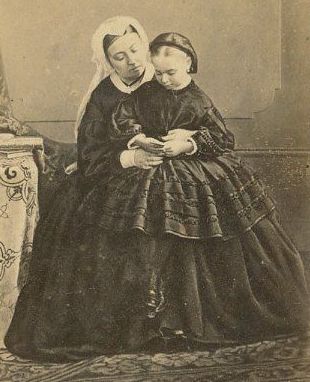
Princess Beatrice - Beatrice Mary Victoria Feodore; 14 April 1857 – 26 October 1944) was a member of the
British Royal Family, the fifth daughter and youngest child of Queen Victoria and Prince Albert.
Victoria had five daughters (Alice, Helena, Beatrice, Victoria and Louise) and four sons (Prince Albert Edward,
Prince Alfred, Prince Arthur and Prince Leopold)
1858—Second Derby ministry succeeded Palmerston. Hebrew disability in Britain removed. Indian mutiny virtually suppressed, and treaty with China.
Queen congratulated the American president over the new Trans-Atlantic cable, August 22.
1859—Queen's first grandchild, Emperor William III, born, January 27. Lord Palmerston succeeded the Earl of Derby (Lord
Derby) as Prime minister in June. Difficulty with China.
1860—Invitation of President Buchanan for the Prince of Wales to visit America accepted by the queen. Anglo-French expedition occupied Peking.
1861 —Duchess of Kent, the queen's mother, died. Queen's third visit to Ireland. Prince consort (Prince Albert) died, December
14. England, France and Spain sent fleets to Mexico.
1862 —United States granted British demand for a release of Mason and Slidell.
1863—Prince of Wales, Albert Edward, Queen Victoria's second child and eldest son married Princess Alexandra Caroline
Marie Charlotte Louise Julia of Denmark, March10; France declared war on Mexico; England and Spain withdraw forces;
Britain renounced renunciation of proteotorate over the lonian Islands.
1864 —Samuel Baker discovered Lake Albert Nyanza (Lake Albert), on the border between Uganda and the Democratic Republic of the
Congo (formerly Zaire), March 14.
1865—Measures taken to suppress Fenians in Ireland (members of the Irish Republican Brotherhood). The Irish Republican Brotherhood or
Fenian Brotherhood was founded in Dublin by James Stephens in 1858. Its aim was to topple British rule and
establish an Irish Republic; Palmerston died; Lord John Russell Prime minister for the second time.
1866—Queen thanked Mr. George Peabody, the American philanthropist, for gifts of $32,750,000 to the London poor; Fenians attempted an
Invasion; establishment of telegraphy between Europe and America.
1867—Fenian insurrection in Ireland; Dominion of Canada constituted reform act passed; outbreak of Abyasian war, ended the
next year.
1868—Benjamin Disraeli, 1st Earl of Beaconsfield, succeeded Derby as Prime minister: reform act for Scotland and Ireland; William Ewart Gladstone
succeeded Disraeli.
1869—Irish church disestablished. The Irish Church Act 1869 (32 & 33 Vict. c. 42) is an Act of the Parliament of the United Kingdom passed during
William Ewart Gladstone's administration.
The Act came into force on 1 January 1871 ; Pacific railway (now The First Transcontinental Railroad) and Suez canal completed.
1870—Empress Eugenie de Montijo (María Eugenia Ignacia Augustina de Palafox Portocarrero de Guzmán y Kirkpatrick),
16th Countess of Teba and 15th Marquise of Ardales, Empress consort of the French, visited the queen. Eugenie was married
to Napoleon III of France. He was emperor of France from 1852 to 1870. ; Irish land act; elementary education act for England
and Wales; Baker led an expedition up the Nile.
1871—Former Emperor Louis Napoleon (Napoleon III) visited the queen; treaty of Washington to settle the Alabama question; Stanley found
Livingstone; grave condition of queen's health announced and the Prince of Wales had typhoid fever.
1872 —Queen was present at the thanksgiving for the Prince of Wales' recovery; America obtains the Alabama award; ballot
bill (Secret Ballot Act 1872) passed. British law that introduced the secret ballot for all parliamentary and municipal elections.
1874—Disraeli succeeded Gladstone as Prime minister: Britain annexed Fiji Island; Ashanti war ended. There were four conflicts
between the Ashanti Empire, in the Akan interior of the Gold Coast, now Ghana, and the British Empire in the 19th century between 1824 and 1901.
The two sides signed the Treaty of Fomena in July 1874, to end the third Anglo-Asante War. The Fourth Anglo-Asante War started in 1894.
1875—Britain bought sultan's share in Suez canal.
1876—Queen was proclaimed Empress of India in London; Constantinople conference opened; closed the next year.
1877 —Queen received General Grant. British took the Transvaal republic.
1873—Britain occupied Cypris. Treaty of Berlin. War against Afghanistan.
1879 —War against the Zulus. Queen's first great grandchild born, Feodora, who was born on 12 May 1879. She was the
daughter of Charlotte (Princess Charlotte of Prussia (Viktoria Elisabeth Auguste Charlotte,a granddaughter of Queen Victoria
and Prince Albert of Saxe-Coburg-Gotha) who became engaged to her second cousin Prince Bernhard of Saxe-Meiningen; Gladstone succeeded Beaconsfield as premier.
Active agrarian movement In Ireland. Roberts entered Candahar. Transvaal uprising.
1881 —Queen telegraphed her sympathy on President Garfield's death, and the court went into mourning. British defeated by
the Boers at Majuba hill; autonomy granted. Irish land bill passed. Parnell imprisoned. Land league manifested. British evacuated Candahar.
Mahdi revolt in Sudan. The Mahdist War (Anglo-Sudan War or the Sudanese Mahdist Revolt) was a colonial
war of the late 19th century. It was fought between the Mahdist Sudanese and the Egyptian and later British forces.
1882—Roderic Mac Lean shot at the queen. Europeans massacred in Alexandria. War against Arabi Pasha, who was defeated. Parnell released.
Lord Cavendish murdered in Dublin. Irish National league formed.
1883—Queen injured by slipping on stairs.
1884—General Gordon shut up in Khartoum which was described as being surrounded by hostile and fanatical Arabs. Franchise bill passed.
In the United Kingdom, the Representation of the People Act 1884 (48 & 49 Vict. c. 3, also known informally
as the Third Reform Act) and the Redistribution Act of the following year were laws which further extended the suffrage in Britain after the Disraeli Government's Reform Act 1867.
Taken together, these measures extended the same voting qualifications as existed in the towns to the countryside, and essentially established the modern one member
constituency as the normal pattern for Parliamentary representation. The act extended the 1867 concessions from the boroughs to the countryside.
All men paying an annual rental of £10 or all those holding land valued at £10 now had the vote.
1885—Irish dynamite outrages in London. Mahdl captured Khartoum. Gordon killed. British force withdrew from the Sudan.
Death of Mahdi. British prepare to meet Russian advance on Herat; settlement effected. Riel rebellion in Canada. Salisbury succeeded Gladstone as Prime minister.
Conquest of Burmah. Canadian Pacific railway completed.
1886—Queen opened the jubilee. Queen sent tha duke of Norfolk to congratulate the pope upon his ecclesiastical Jubiles.
1888—Queen present at the celebration of the Prince of Wales silver wedding. Fisheries treaty with the United States rejected
by the senate. Osman Digna defeated near Suakim. Osman Digna was a follower of the Mahdi in the Sudan. Suakin or Sawakin
is a port in north-eastern Sudan, on the west coast of the Red Sea.
1889 —British collision with Portugal in southeast Africa. Samoan conference with the United States and Germany. The Treaty
of Berlin was the concluding document of the conference at Berlin in 1889 on Samoa.
1890—Portugal yielded to British demands. Treaty with Germany, defining spheres in Africa and ceding Heligoland to Germany
in order to safeguard Britain's African interests. Protectorate over Zanzibar assumed.
1891 —Queen reviewed the French fleet which arrived at Spithead. The French fleet, which consisted of seven vessels, was officially welcomed by H.R.H. the Duke of Connaught.
Admiral Jervaise and the principal officers of the squadron were afterwards received at Osbone by her Majesty the Queen and Princesses Louise and Beatrice, 20th August.
The queen, onboard the royal yacht Victoria and Albert, reviewed the French fleet, 21st August. Osman Digna completely defeated.
1892 —Duke of Clarence (Prince Albert Victor, Duke of Clarence and Avondale, eldest son of Albert Edward, Prince of Wales
(later King Edward VII), and the grandson of the reigning British monarch, Queen Victoria, died.
Agreement with the United States to arbitrate the Bering sea seal fisheries dispute. Gladstone succeeded Lord Salisbury as Prime minister.
1893—Queen opened the Imperial Institute on 2 May. Home rule bill introduced. Bering sea arbitration awarded against America.
British East Africa company defeated the king of Matabeleland.
1894—Queen formally inaugurated the Manchester ship canal. The canal is an inland waterway 36 miles (58 km) long in the
North West of England. Starting at the Mersey Estuary near Liverpool.
Prince Edward of York (Edward VIII - Edward Albert Christian George Andrew Patrick David, later the Duke of Windsor, was born on June 23. He was the eldest son of King
George V and Queen Mary. Edward became king when his father died in early 1936 but abdicated on 11 December 1936.
He proposed marriage to the American socialite Wallis Simpson, who had divorced her first husband and was seeking a divorce
from her second.
The prime ministers of the United Kingdom and the Dominions opposed the marriage, arguing that the people would
never accept a divorced woman with two living ex-husbands as queen. Additionally, such a marriage would have conflicted with Edward's status
as the titular head of the Church of England. Edward knew that the government led by prime minister Stanley Baldwin
would resign if the marriage went ahead, which could have forced a general election and would ruin his status
as a politically neutral constitutional monarch. Choosing not to end his relationship with Simpson, Edward abdicated.
Rosebery succeeded Gladstone as Prime minister.
1895—Salisbury succeeded Rosebery. President Cleveland sent his message to Great Britain regarding ths Venezuelan boundary dispute.
1896—Queen received Li Hung Chang (Li Hongzhang). August 5, LI Hung Chang and suite went by special train to Portsmouth
in order to cross the Solent to the Isle of Wight and visit the queen at Osborne. A salute of nineteen guns was fired when he
boarded tho royal yacht Alberta. On leaving Portsmouth the yacht made a detour and gave the distinguished traveler a view of a large fleet of
warships assembled ln those waters. The Chinese statesman was saluted by the fleet, and continued on his way
to the Trinity wharf, Cowes, where he was received by the Prince of Wales, who escorted him to Osborne. The Marquis of
Salisbury, who presented Li Hung Chang to her majesty, had preceded the Chinese envoy to the Isle of Wight.
When the royal yacht Alberta arrived at Cowes Li Hung Chang was received with national honors. He was driven from tho landing to
Osborne House in a royal carriage drawn by four horses, and upon his arrival there was shown to the private apartments
set aside for his use. He was then presented to the Prince of Wales and the Duke of York in the reception room. Li Hung Chang and his suite,
Lord Salisbury and others took lunch together in Osborne House, while the queen and other royalties took lunch
in a private apartment.
Afterward the Chinese envoy was ushered into the presence of the queen, who was seated in a small
gilded chair, dressed in black, and surrounded by members of tho royal family. Lord Salisbury presented Li Hung Chang, and in response the queen
bowed to the nation's guest, but did not arise. LI Hung Chang then read a speech in the Chinese language, which his son, Viscount Li, translated.
He said in substance that he had been commanded by his master, the Emperor of China,
to pay his respects to her majesty, and that he had traveled many miles to carry out its mandates. He then handed to the queen
a large yellow silk envelope containing his credentials.
The queen in reply said that she was glad to see his excellency, and remarked that he had had a long journey. Her majesty
also said that she reciprocated the good will of the Chinese emperor.
The queen then, for the first time, arose and remained standing, when Li Hung Chang retired from her presence bowing.
Ll Hung Chang afterward boarded the royal yacht Osborne to be presented to the Princess of Wales. After taking tea on board
the Osborne Li Hung Chang returned to tho royal yacht. Alberta, which then steamed back to Portsmouth through the lines of
the fleet.
The sailors manned the ships as the yacht passed, and LI Hung Chang did not conceal his admiration of the imposing spectacle,
comprising some fortyseven vessels of the British navy, of which twenty-seven were battleships. This was the strongest
fleet assembled since the review in honor of the queen's jubilee. Los Angeles Herald, 6 August 1896.
The queen, on the 23rd of September, 1896, had reigned longer than any British sovereign.
Great Britain acceded to American demand for Venezuelan arbitration. Jamieson raid. Ashantis compelled to accept British. Kitchener occupied Dongola.
1897—Queen's diamond Jubilee celebrated. Senate rejected Anglo-American treaty. Autonomy of Crete declared by the powers.
Grand Duchess Tatiana, of Russia, the queen's thirtieth great grandchild, born. Revolt of Indian Hill tribes on the Afghan border.
1898 —Two-cent postage went into effect between Great Britain and the colonies.
1898— Dervish force surrendered. Venezuelan arbitration award a compromise. Transvaal declared war October 11. Colonies
rallied to the support of Great Britain. Agreement with America and Germany for the partition of Samoa.
1900—Queen welcomed in Ireland. International expedition occupied Peking. Australian colonies form the commonwealth of Australia.
Transvaal and Orange Free State movement.
Queen Victoria died on Tuesday, 22 January 1901, at the age of 81at Osborne House on the Isle of Wight.
The eldest son and second child of Queen Victoria and Prince Albert of Saxe-Coburg and Gotha, Edward VII was
King of the United Kingdom and the British Dominions and Emperor of India from 22 January 1901 until his death on
6 May 1910. His successor was George V (6 May 1910 – 20 January 1936). His successor was Edward VIII, who
abdicated (20 January – 11 December 1936). He was succeeded by his younger brother Albert (George VI).
(11 December 1936 – 6 February 1952). George VI was married to Elizabeth Angela Marguerite Bowes-Lyon.
Elizabeth Angela Marguerite Bowes-Lyon was the youngest daughter and the ninth of ten children of
Claude Bowes-Lyon, Lord Glamis (later the 14th Earl of Strathmore and Kinghorne in the Peerage of Scotland),
and his wife, Cecilia Cavendish-Bentinck. Elizabeth Angela Marguerite Bowes-Lyon was later known as Queen
Elizabeth The Queen Mother. She was queen consort of the United Kingdom from her husband's accession in 1936
until his death in 1952, after which she was known as Queen Elizabeth The Queen Mother. Albert's elder daughter,
Elizabeth (Elizabeth II), succeeded him. (6 February 1952 – present).